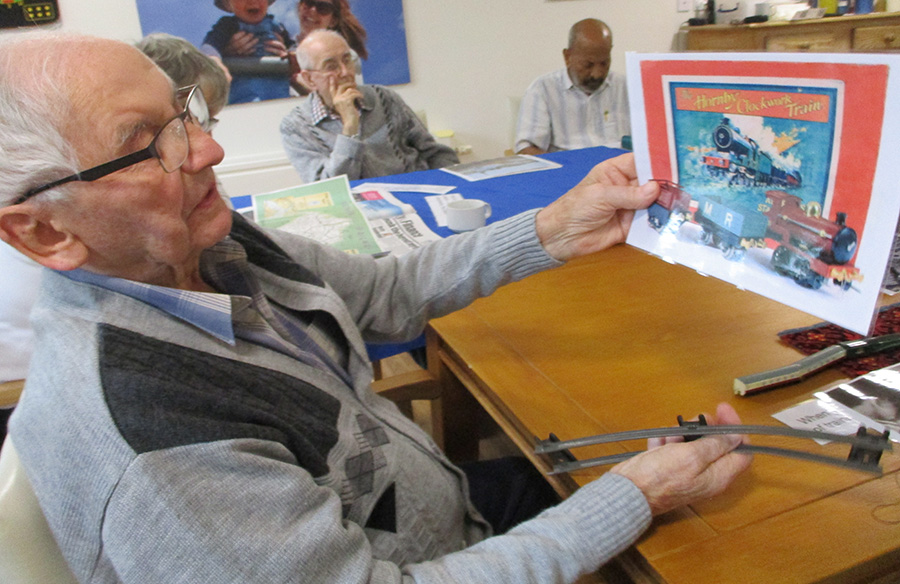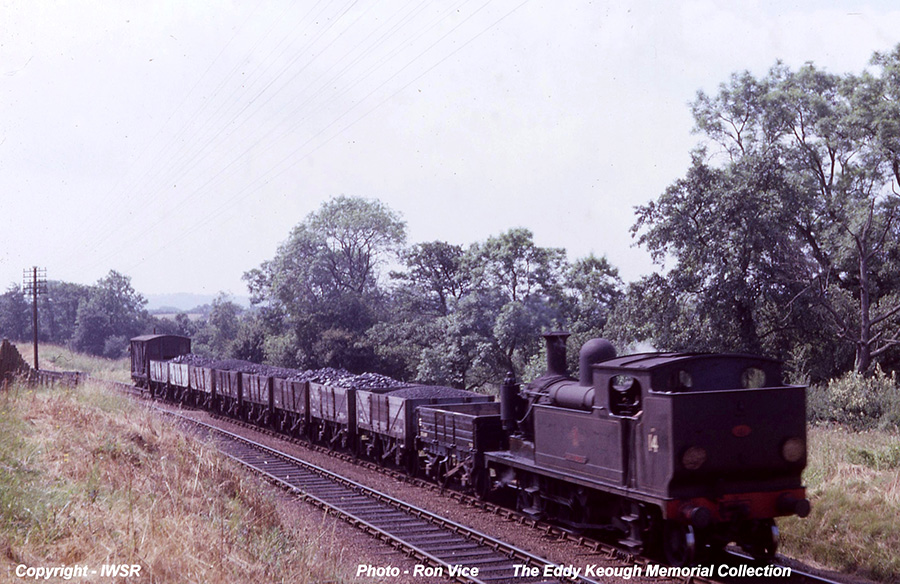Railway Reminiscences
Railways bring an air of nostalgia to many people, whether they used to work on the railways or they have been involved in volunteering at the Isle of Wight Steam Railway. They may have visited the Island as a child and travelled on one of the steam engines or perhaps on the Ryde Pier railcar. The memories that these people hold are valuable to us and help tell the story of the Railway from a human perspective, reimagining the sights, sounds and smells.
Railway Reminiscences feature the reflections of people connected to the Isle of Wight Steam Railway. These memories are either written memoirs, transcriptions from oral history recordings or soundbites from oral history projects. They often relate to objects or themes across the Railway:

Goods Brake Van Memories
In steam days every goods train had a brake van at the rear in which the Guard rode. Guards were in charge of the train and their job was to ensure its safe running.
A brake van was so-called because it had its own manual ‘braking system’ that the Guard could operate to assist the Driver with slowing down or stopping the train.
On the Isle of Wight, most Goods Brake Vans originated from the London & South Western Railway and had space to carry small packages etc for delivery to wayside stations and were known as ‘Road Vans’. An example of this type – numbered 56046 – may usually be seen in Train Story.
This vehicle, number 55724, was transferred to the Island in 1967 for use with Engineering Department trains. It is of a standard Southern Railway design and was solely to accommodate the Guard. It is painted in the livery it would have carried when new in 1934.

Iain Whitlam, long-time member of the Railway, volunteer and Trustee, remembers;
I travelled with an inspector in a goods brake van from Newport to Ryde, of a locomotive coal train in 1965. We passed through the loop at Havenstreet rather faster than the official speed for exchanging tokens – with a heavy train, the driver was keen to take a run at the bank up to Rowlands Lane bridge rather than lose adhesion and come to a stall on the gradient. I thus found myself being flung from one side of the balcony to the other on the reverse curves through the Up platform! (The inspector knew what was coming, so had taken the precaution of sitting firmly inside the van.)
Andrew Britton writes of an incident when the ballast train ran away from Wroxall;
The guard aboard wasn’t properly qualified but was porter-guard and didn’t know the braking system. The signalman… was notified that the loose train was heading towards him. There being no traffic on the line, he let it go through the station towards Sandown. At Sandown, (the) Signalman… should have directed the runaway train into Brickfields siding or Ditches siding. Instead, the train continued through towards Brading up to Whitefield Woods where it briefly halted and then it rolled back until it eventually stopped at Brading.
The two Signalmen ‘were reprimanded for not directing the runaway train into a dead end siding and ‘smashing it up’.

Schoolboy memories of the Freshwater – Yarmouth – Newport Railway by Peter McCullagh
I started school in Newport in April 1951 and every school-day my brother and I would make our way down Hooke Hill to Freshwater Railway Station, urged on by the earnest panting of the brake pump of the train waiting to leave at 7:50 for Newport. The engine was invariably an Adams 02 and usually three coaches made up the train.
The railway staff got to know us quite well and if we were late arriving the guard, would stop the train and take us into the guard’s van, from which we would emerge at Yarmouth station and find a compartment, usually we could find a compartment to ourselves there being something in the region of 20 or 25 passengers travelling on that service.
The line ran up hill and down dale but the only climb which caused our engine any grief was found on the way from Yarmouth to Ningwood, where there was a rise of 1:64 and sometimes it would lose its feet.
After calling at Calbourne and Shalfleet Station the train would call at Watchingwell Halt, which was very rural, and pick up milk churns, perhaps ten in number. We discovered that this was a private halt when we made an abortive attempt to change compartments and were ordered back from whence, we came.
The line rose as it left the halt and it was this climb that on one occasion the engine appeared to die and the train came to a halt. It had run out of steam, however after five minutes, presumably of frantic stoking, progress resumed. Apart from this hiccup there was never any breakdown either of the train we were on, or on the part of the train at Ningwood station being the only passing place, the line being single track.
Because of the many curves in the line there were few places to reach any speed save for the descent into Carisbrooke, where there had once been a siding serving a back factory. This section was christened by my brother as the “loose rails” owing to the rapid rattling where the points had been removed. The train from Freshwater would arrive at Newport station at 8:27 or so, making the journey including stops, less than 40mins.
As the train approached Newport from Carisbrooke it passed Victoria Recreation ground and as it was descending towards Towngate viaduct there were four long whistles from the front of the train, which we understood to be a coded warning to the signalman at Newport North Signalbox of the approach of a train. Sometimes the coal yard at station approach was busy and we had to stand for a moment on the curved brick part of the viaduct before the way become clear to enter the station.
As we entered the station the driver would reach out of the cab with the token for the section of line between Ningwood and Newport and hand it to the signalman, The train then went north towards Cowes and the point would be switched for the train to be pushed into the platform for Ryde.
On the return journey the train would be stationary on the west bay and would leave at 4pm or 4:05. The engine would be at the buffer end of West Bay and it would push the coaches towards Cowes, going some way past the Newport North Signalbox. It would then come to a standstill.
Sometimes one could hear the sound of the points and/or signals being changed, and thereupon the engine would whistle and process past the signalbox, and as it passed the driver would take the said token from the signalman, the train then proceeding southwards and then westwards to enter Towngate viaduct.
I well remember looking almost vertically down from the metal section of the viaduct on folk having tea in their garden and they would wave and smile to us.
At almost the same moment as the Freshwater train left the West Bay, going northwards the Cowes train would leave form the adjacent platform, and for nearly half a minute the trains would run adjacent to each other and be quite close. We had friends on the Cowes train and on several occasions, we passed comics from one train to the other. They were usually of the Captain Marvel variety, which could be bought from the stationers in the station.
The jewel in the crown in these halcyon days gone by, alas like our youth too soon, was the Holiday Roundabout Ticket available during the summer months. For five shillings (25 pence) you had the freedom of the whole Island railway for six days, Monday to Saturday.
Peter McCullagh – 2022
Women on the Railways
Sarah Tagart Interview by Sarah Rae Draws – International Women’s Day 2023
The Heritage and Learning team acquired a painting by steam enthusiast and wildlife artist, David Shepherd in Spring 2023. Iain Whitlam remembers the day David came to Ryde Works in November 1966, just before the end of Steam on the Island.
The story around the David Shepherd Ryde Motive Power Depot sketch painting by Iain Whitlam.
On Monday 7 November 1966, Desmond Hawkins, David Perry, Ron Strutt and I caught the 02.30 newspaper train from Waterloo (hauled by steam – I noted West Country Class 34071 as in charge) and the 06.40 boat from Portsmouth. To pass time, we travelled to Cowes and back to Ryde St John’s Road. There we met up with Ron’s father and Tony Bennett, who had travelled at a more civilised hour and we were introduced to artist David Shepherd. He had arrived, complete with family, in his Landrover.
Whilst our group visited Ryde Works to discuss which O2 Class we would purchase, David Shepherd set up an easel in the locomotive shed and sketched the scene. He had been earnestly visiting various locomotive sheds capturing the soon-to-disappear atmosphere of steam locomotives. This enthusiasm was what had led to him walking into Ian Allan’s offices at Shepperton seeking to help someone rescue a steam locomotive … and being put in touch with the Wight Locomotive Society, resulting in giving us enough funds to succeed in our endeavour.
W24 Calbourne needed to shunt out of the shed to release a locomotive into service. The accompanying photograph shows David asking for a lift in the cab back into the shed – whilst the released locomotive can be seen departing and Tony Bennett can be seen in the left of the view.
If I recall correctly, Mrs Shepherd and the daughters spent the day being tourists – the weather was nice enough to include a visit to the beach.
When we had completed discussions in the Works, David appeared much grubbier than he had arrived, complete with this sketch. He waxed lyrical at the idea of repainting one of the LBSCR wagons – sadly this never happened.
(David later went on to buy his own locomotives, BR Standard 9F Class 92203 Black Prince and 4MT Class 75029 Green Knight, leading to the setting up of the East Somerset Railway.)
The early-bird four of us took return trips to Shanklin and Newport to get our money’s worth from our rover tickets, before returning to the mainland.




